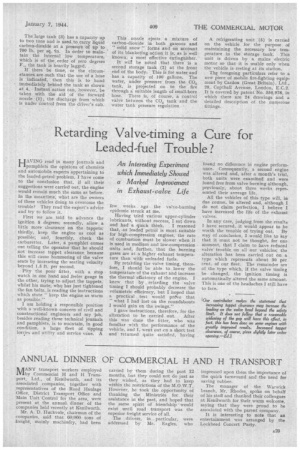Retarding Valve-timing a Cure for Leaded-fuel Trouble?
Page 25

If you've noticed an error in this article please click here to report it so we can fix it.
HAVING read M many journals and pamphlets the opinions of chemists and automobile experts appertaining to the leaded-petrol problem, I have come to the' conclusion that, if all their suggestions were carried out, the engine would remain much the same as before. In the meantime, what are the owners of these vehicles doing to overcome the trouble? They read the expert's advice and try to follow it.
First we are told to advance the ignition 6 degrees; secondly, allow a little more clearance on the tappets: thirdly, keep the engine as cool as possible; and, fourthly, check the carburetter. Later, a pamphlet comes out telling the operator that he should not increase tappet clearance because this will cause hammering of the carve seats by increasing the seating velocity beyond 1.5 ft. per second.
Pity the poor fitter, with a stop watch in one hand and feeler gauge in the other, trying to adjust the tappets, whilst his mate, who has just tightened the fan belts, is reading the instructions which state " keep the engine as warm as possible."
I am holding a responsible position with a well-known concern of civil and constructional engineers and my job, besides reading these technical journals and pamphlets, is to maintain, in good condition, a large fleet of tipping lorries and utility and service vans. A
few, weeks ago the valve-burning epidemic-struck at me.
Having tried various upper-cylinder lubricants, without success, I sat down and had a quick think.. I reasoned that, as leaded petrol is most suitable for high-compression engines, the rate of combustion must be slower 1,vben,it is used in medium and low-compression units and, further, that the burning gases are at a higher exhaust temperature than with unleaded fuels.
By reta-rding the valve timing, therefore, I should be able to lower the temperature of the exhaust and increase the thermal efficiency of the engine. I knew that by retarding the -valve timing I should probably decrease the volumetric efficiency, but I hoped that a practical . test would prove that "what I had lost on the roundabouts I would gain on the swings."
I gave instructions, therefore, for the alteration to be carried out. After this was done the fitter, who was familiar with the performance of the vehicle, and I, went out on a short test and returned quite satisfied, having found no difference in engine performance. Consequently, a second engine was altered and, after a month's trial, both units were examined and were found free from valve burning although, previously, about three weeks represented their average life..
All the vehicles of this type will, in due coursee.be altered and, although I do not claim perfection, I believe I have increased the life of the exhaust valves.
In any case, judging from the results I. have secured, it would appear to ,be worth the trouble of trying out, By way of conclusion, I would like to Say that it must not be thought, for one moment, that I claim to have reduced valve trouble on all our vehicles; the alteration has been carried out on a type which represents about 30 per cent, of our fleet. The remainder are of the type which, if the valve timing be changed, the ignition timing is automatically altered the same amount. This is one of the headaches I still have to face.




















































